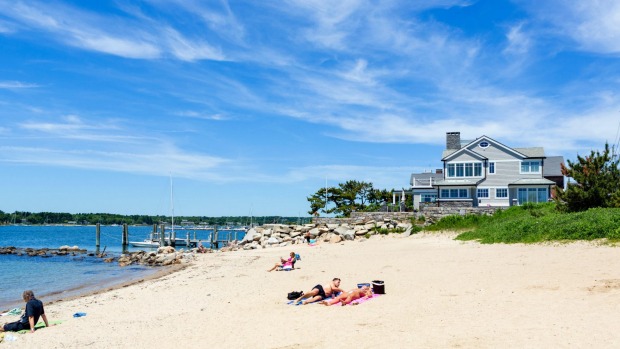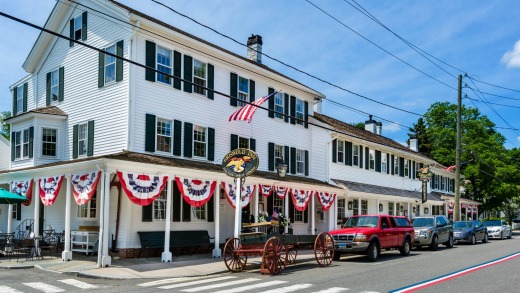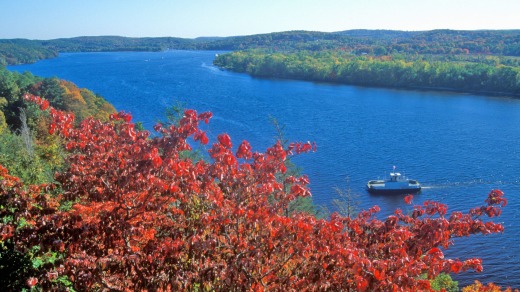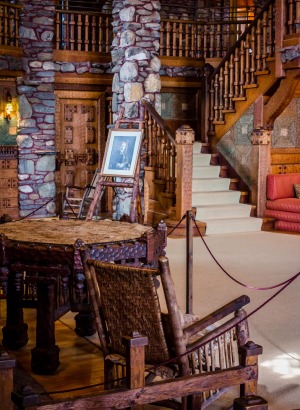
Only 30 minutes' drive north from New York, and we seemed to be on a different planet. Instead of the frenetic pace, the crowds, and the roaring traffic, we were among dense beech and oak forests interspersed with clusters of colonial-style clapboard cottages, many of which were flying American flags. It was autumn, and the maples, oaks, and sycamores blazed russet and gold, and piles of huge pumpkins were heaped on doorsteps in anticipation of Halloween. This was Connecticut, an area of New England that is often overlooked in favour of its more famous neighbours Maine, Massachusetts and Vermont. And that neglect is what makes Connecticut ideal for touring.
The Connecticut River Valley is an area of pristine scenery and historic villages of great charm. We stayed at the Copper Beech Inn at Ivoryton, a pretty hamlet which was an ideal base for exploring the surrounding area. Its unusual name derives from the ivory industry that once flourished here and produced buttons, billiard balls and piano keys. I was surprised to see that this tiny place had a well-known theatre, the Ivoryton Playhouse, which stages excellent productions in a delightful country atmosphere which once featured Katharine Hepburn and Marlon Brando. As I strolled beside the river that winds through the village, I gazed at the magnificent beech trees, and felt my soul expanding and my heartbeat slowing down.
Ivoryton is part of Essex, a picturesque township on the banks of the Connecticut River. It was a ship-building centre in the 17th century, and prints of some of those early sailing ships and steamboats now decorate the walls of one of its famous country inns.

The Griswold Inn, which opened in 1776, is one of the oldest continuously open inns in the United States, and from the moment I stood under its low timber ceiling, and walked along its uneven old floorboards, I felt I'd stepped into 18th-century New England. Past the collection of antique firearms, and a framed notice from a Mississippi paddle steamer which ordered gamblers and fast women to report to the captain, we entered a large dining room whose decor evoked the old sailing days. That impression was reinforced as the evening wore on, and the lively crowd in the adjoining bar began singing traditional sea shanties. My lobster hotpot in sherry cream sauce which was topped by a puff pastry lid was delicious but so huge they must have put a whole lobster in it.
Not far from Essex, near the mouth of the Connecticut River we came to Old Lyme, once the home of sea captains. It was thanks to the daughter of one of them that it has become synonymous with art. When her sea captain father lost all his money, Florence Griswold turned her home into a boarding house for the artists who were inspired by the pristine landscape of Connecticut. She became their patron when she opened her doors in 1899, and charged them $7 a week for bed and board. It's interesting to wander around her colonnaded Georgian style villa, which now houses an excellent collection of American Impressionist art not only on the walls but also on the door panels and wood panelling of some rooms where her proteges left their wonderful paintings.
The house stands on large grounds that roll down to the river and include a museum that features the work of contemporary artists. Visitors have picnics on the lawn while their children run around the gardens, delighted by the whimsical art on display at the Wee Faerie Village. FlorenceGriswoldMuseum.org

One of the most attractive and well-preserved villages in the valley is Chester which was settled in 1692 and was a milltown and ship-building community. It has excellent restaurants, one of which is the River Tavern which overlooks the water, serves delicious food, and charges half price for wine on Tuesday nights. While strolling along the main street I came across the town's popular artist Leif Nilsson, at work on his easel, painting one of the town's flower-filled cottages. Chester's main street resembles an illustration from a picture book, and it would be easy to dismiss the enticing antique shops, galleries and cafes with their flags, pumpkin decorations and lace curtains as "quaintsville" but this is traditional Connecticut and not a kitschy show for tourists.
A brief crossing on the Chester-Hadlyme ferry which began service in 1769 and costs US$5 per vehicle ($6 on weekends), took us to East Haddam. We'd come to see the remarkable Gillette Castle, a strange turreted edifice built by William Gillette in 1919. Perched high on a bluff looming over the spectacular landscape, its primitive facade of jagged stones and rough stone wall made me think of the Flintstones, but the gloomy entrance with its black grout resembled a Transylvanian dungeon.
Gillette had been a popular actor who made his fortune playing the role of Sherlock Holmes, but his eccentric personality was apparent in every aspect of this peculiar building which had a theatrical atmosphere. The 47 hand-carved doors of white oak were intricately designed and no two were the same. Large wooden toggles dangled off the edge of the dining table to amuse Gillette's sixteen cats. An unusual host, he used to spy on his visitors from a concealed mirror upstairs, and played tricks on them so they couldn't open the liquor cabinet. His guests included Charlie Chaplin and Albert Einstein who was terrified when Gillette drove his train which hurtled along the three-mile track he had constructed on his estate. The magnificent 50-hectare grounds include picnic areas and hiking trails.

Not far from Gillette Castle is the Goodspeed Opera House. This Victorian music hall was built in the 1870s, a period when East Haddam was popular with New Yorkers. It stages American musicals from April to December. goodspeed.org
This delightful fishing village built on a narrow peninsula jutting out to sea has an interesting history, and the long street that leads to the Atlantic is lined with the original clapboard cottages of the Portuguese fishermen who once settled here. Forty-nine steps lead to the top of the unusual stone lighthouse giving an expansive view over the sea and the yachts bobbing in the water.
Not far from Stonington, whose lovely harbour was once full of whaling ships, is Mystic. The remarkable Mystic Seaport Museum is a brilliant recreation of a 19th-century New England whaling village, and you could easily spend a day wandering around the historic buildings and vessels spread out along the Mystic River. You can board the last surviving wooden whaling ship in the world, and hear lectures about whaling and oystering.
Speaking of oysters, the best ones in this region come from Noank. This surprising little village, whose 18th and 19th-century houses and shipyards are listed in the National Register of Historic Places, is also renowned for its seafood. Its seafood restaurants and outdoor shacks serve delicious lobster rolls and clam chowder. With its historic buildings, beautiful marina and outstanding seafood, Noank is another of Connecticut's undiscovered gems.
www.visitconnecticut.com
The Connecticut River Valley is a two-hour drive from New York.
The Copper Beech Inn at Ivoryton is a four-star hotel with an old-world atmosphere, forest-like grounds, and spacious rooms. Room rates from around US$250. Email [email protected]
The Bee & Thistle Inn & Spa at Old Lyme is an attractive Dutch colonial farmhouse with lovely gardens and nine rooms furnished with antiques. See www.beeandthistleinn.com
Late September-October is the best time to see the spectacular autumn foliage, but some cafes and tourist facilities close after Labour Day in September.